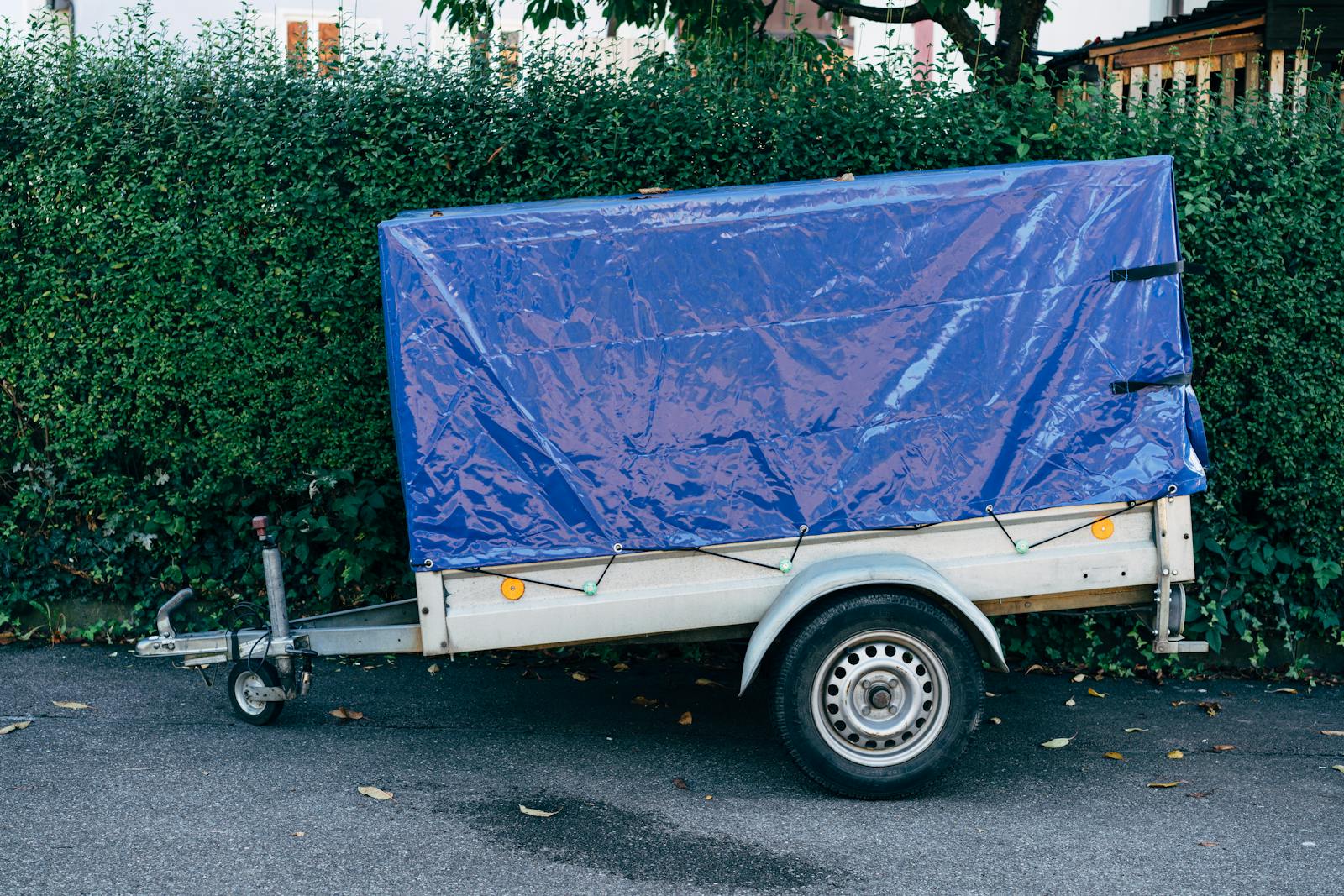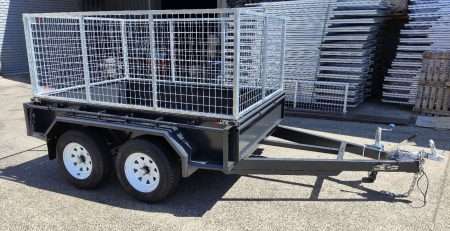
Mastering Tandem Trailer Axle Placement: Tips and Tricks
Proper tandem trailer axle placement is crucial for safe and efficient towing. It has a significant impact on weight distribution, stability, and overall trailer performance. Correct positioning of axles ensures balanced load distribution, improved handling, and reduced wear on tires and suspension components. This makes understanding tandem trailer axle placement essential for anyone who uses or maintains trailers.
This article will explore the fundamentals of tandem axle trailer setup, including how to calculate the ideal axle position. It will also cover techniques to fine-tune axle placement for optimal performance and common mistakes to avoid. By the end, readers will have a comprehensive understanding of tandem trailer axle positioning and be equipped with practical tips to enhance their trailer’s safety and efficiency.
Understanding Tandem Axle Trailer Basics
Definition of tandem axle trailers
Tandem axle trailers are a type of trailer that features two axles positioned close together, typically spaced no more than 4 feet apart. This design provides additional support and balance for carrying heavy loads. Tandem axle trailers are built with excellent stability and can bear more weight compared to single-axle trailers, making them ideal for hauling heavier items such as boats, ATVs, and larger recreational vehicles.
These trailers come in various styles, including fifth-wheel trailers, gooseneck trailers, and tag-along trailers. The most common type is the fifth-wheel trailer. Regardless of the style, tandem axle trailers offer the durability and strength needed for various hauling needs.
Importance of proper axle placement
Proper axle placement is crucial for the safe and efficient operation of tandem axle trailers. The positioning of the axles has a significant impact on weight distribution, stability, and overall trailer performance. When the axles are correctly placed, it ensures balanced load distribution, improved handling, and reduced wear on tires and suspension components.
One of the key factors in proper axle placement is achieving the right tongue weight. Ideally, about 10 to 15 percent of the total trailer weight should be placed on the tongue. This weight distribution helps maintain stability and control while towing.
Factors affecting axle positioning
Several factors influence the optimal positioning of axles on a tandem trailer:
- Trailer length: The total length of the trailer box plays a role in determining the axle position. For each foot of total box length, the centerline of the axles should be moved toward the back of the trailer by 1 inch from the centerline of the trailer box.
- Load distribution: The layout of the trailer and the placement of permanent weight inside, such as furniture, toolboxes, or shelving, affect the ideal axle location.
- Type of cargo: Different types of cargo may require adjustments in axle placement. For example, boat trailers often have the axle set back further than traditional trailers because the majority of the weight is at the back of the trailer.
- Legal requirements: It’s important to consider the Bridge Table Formula when positioning axles to ensure compliance with legal regulations.
- State-specific regulations: Different states may have varying requirements for axle placement. When planning a route through multiple states, it’s advisable to use the most stringent (shortest distance from the kingpin) setting to ensure compliance.
- Weight transfer: The amount of weight transferred when adjusting axle position depends on factors such as load distribution and the distance between each hole in the tandem slider rail. Generally, each tandem hole accounts for approximately 250 pounds of weight transfer.
By considering these factors and making appropriate adjustments, trailer owners can optimize the performance, safety, and legal compliance of their tandem axle trailers.
Image Source: AI Generated
Calculating the Ideal Axle Position
The 40% rule for axle placement
When it comes to tandem trailer axle placement, a common rule of thumb is the 40% rule. This guideline suggests that approximately 60% of the trailer should be ahead of the axles, while 40% should be behind them. This distribution helps achieve proper weight balance and stability during towing.
To implement the 40% rule, trailer owners can adjust the axle position by sliding it back and forth on the frame until they achieve the desired weight distribution. The goal is to have between 75 and 100 pounds of tongue weight. This method allows for fine-tuning the tandem trailer axle positioning to ensure optimal performance and safety.
Measuring trailer box length
Before calculating the ideal axle position, it’s crucial to accurately measure the trailer box length. To do this, start by taking a common measurement from the front of the spring to the front of the trailer. Repeat this measurement on both sides to ensure accuracy.
When measuring trailer length, it’s important to note that different manufacturers may use varying methods. Some measure from the back bumper to the coupler, while others measure only the box size from front to rear. For consistency, it’s best to follow the RVIA guidelines, which state that the advertised length should be the usable floor plan length, excluding the tongue and rear bumper.
Step-by-step calculation process
To calculate the ideal axle position for a tandem trailer, follow these steps:
- Establish the current weight distribution:
- Load the trailer as it will be used on the road.
- Use a vehicle scale to measure the weight at the wheels and the total trailer weight.
- Calculate the center of mass (CG):
- Measure the length from the ball to the center of the wheel set (L6(a)).
- Use the formula: Lcg = L6(a) * Ww/Wcg, where Ww is the weight at the wheels and Wcg is the total trailer weight.
- Determine the desired tongue weight:
- Choose a percentage between 10% and 15% of the total trailer weight.
- Calculate the desired tongue weight (Ft) and axle weight (Fa).
- Calculate the ideal axle position:
- Use the formula: L6 = Lcg * Wcg/Fa, where L6 is the desired axle position.
- Make adjustments:
- Move the axles forward or backward based on the calculations.
- Fine-tune the position to achieve the desired weight distribution.
Remember that these calculations are based on accurate weight measurements. If you can’t load the trailer completely as it would be for driving, the calculations become estimates. It’s crucial to verify that the resulting loads are suitable for your tow vehicle and to make judgments about distances and loading as you go.
By following this step-by-step process, you can determine the optimal tandem trailer axle positioning for your specific trailer configuration. This will help ensure proper weight distribution, stability, and safe towing experiences.
Fine-Tuning Axle Placement for Optimal Performance
Adjusting for tongue weight
Fine-tuning tandem trailer axle placement is crucial for achieving optimal performance and safety. One of the key factors to consider is the tongue weight, which plays a significant role in trailer stability. The ideal tongue weight should be between 10% and 15% of the overall loaded weight of the trailer. This balance ensures that the trailer remains stable during towing and prevents dangerous swinging or swaying.
To adjust the tongue weight, trailer owners can manipulate the position of the cargo. Moving the cargo closer to the hitch ball increases the tongue weight, while shifting it away from the hitch ball decreases it. This adjustment allows for precise control over the weight distribution and helps achieve the desired balance.
Considering load distribution
Proper load distribution is essential for tandem trailer axle setup. The goal is to evenly distribute the weight between the two axles while maintaining the correct tongue weight. A common rule of thumb is to position the center line of the load just in front of the center line of the wheels for a tandem axle trailer. This placement helps achieve a balanced weight distribution and applies a slight bit of nose weight to the towing vehicle.
It’s important to note that different types of trailers may require specific load distribution techniques. For example, boat trailers often have the axle set back further than traditional trailers because the majority of the weight is at the back of the trailer. Trailer owners should consult their manufacturer’s guidelines or seek professional advice for specific load distribution recommendations.
Balancing stability and maneuverability
Finding the right balance between stability and maneuverability is crucial for optimal tandem trailer axle positioning. While stability promotes steady movement and reduces the energetic cost of locomotion, maneuverability allows for controlled changes in direction and speed. Trailer design must strike a compromise between these two factors to ensure safe and efficient towing.
To enhance stability, consider the following:
- Ensure proper weight distribution between the axles.
- Maintain the recommended tongue weight.
- Position the center of gravity slightly in front of the axle centerline.
For improved maneuverability:
- Adjust the axle position to allow for tighter turns when necessary.
- Consider the trailer’s intended use and typical load types.
- Be mindful of the trade-off between turn radius and turning rate.
By carefully considering these factors and making appropriate adjustments, trailer owners can optimize their tandem trailer axle placement for both stability and maneuverability. Regular checks and adjustments may be necessary to maintain optimal performance, especially when dealing with varying load types or changing towing conditions.
Common Mistakes to Avoid in Tandem Axle Placement
Positioning axles too far forward or backward
One of the most common errors in tandem trailer axle placement is positioning the axles too far forward or backward. This mistake can lead to significant issues with trailer stability and performance. When the axles are placed too far back, it can cause excessive tongue weight, resulting in undue wear on the tow vehicle’s suspension and tires. Conversely, if the axles are positioned too far forward, the tongue weight may be insufficient, leading to dangerous trailer sway.
To avoid this mistake, it’s crucial to aim for the ideal tongue weight, which should be approximately 10 to 15 percent of the total trailer weight. If the tongue weight is less than this range, the axles need to be moved further away from the trailer tongue, closer to the back of the trailer. If it’s greater than this range, the axles should be moved closer to the trailer tongue and the front of the trailer.
Ignoring trailer type specifics
Another common error is failing to consider the specific requirements of different trailer types. For instance, boat trailers often require a different axle placement compared to traditional trailers. In boat trailers, the axle is typically set back further because the majority of the weight is at the back of the trailer. This adjustment is necessary to achieve the appropriate tongue weight for safe towing.
It’s essential to understand that different trailer types may have unique weight distribution patterns. Ignoring these specifics can lead to poor weight balance and potentially dangerous towing conditions. Trailer owners should always consult manufacturer guidelines or seek professional advice when determining the optimal axle placement for their specific trailer type.
Overlooking weight distribution
Proper weight distribution is crucial for safe and efficient towing, yet it’s often overlooked when placing tandem trailer axles. Ideally, the center line of the load should be just in front of the center line of the wheels for a tandem axle trailer. This placement helps achieve a balanced weight distribution and applies a slight bit of nose weight to the towing vehicle.
When weight distribution is not properly considered, it can lead to uneven tire wear and poor trailer handling. For example, if there’s consistently a difference in temperature between the front two hubs and the rear two, it might indicate that the hitch is too high or too low. Similarly, if both hubs on one side are warmer, it could suggest that the load is off-center to that side.
To avoid this mistake, it’s important to carefully consider the layout of the trailer and the placement of permanent weight inside, such as furniture, toolboxes, or shelving. Additionally, trailer owners should be prepared to make adjustments based on different load types and towing conditions. Regular checks and fine-tuning of the weight distribution can help maintain optimal performance and safety of the tandem trailer.
By avoiding these common mistakes in tandem trailer axle placement, trailer owners can ensure better stability, improved handling, and safer towing experiences.
Conclusion
Mastering tandem trailer axle placement is crucial to ensure safe and efficient towing. This article has explored the fundamentals of tandem axle trailer setup, including how to calculate the ideal axle position and techniques to fine-tune placement for optimal performance. By understanding these principles and avoiding common mistakes, trailer owners can enhance their trailer’s stability, handling, and overall safety on the road.
The key takeaway is that proper axle positioning has a significant impact on weight distribution and trailer performance. To achieve the best results, it’s essential to consider factors such as trailer length, load distribution, and specific trailer types. Regular checks and adjustments may be necessary to maintain optimal performance, especially when dealing with varying load types or changing towing conditions. By applying these insights, trailer owners can enjoy safer and more efficient towing experiences.
FAQs
Q: How should tandem axles be positioned on a trailer?
A: For both single and tandem axle setups, the axles should be positioned at 40% of the trailer bed’s length from the rear end. In a tandem axle setup, this 40% mark should align with the center of the equalizer, using a trailing arm for stable axle mounting.
Q: What is the method to determine the placement of an axle on a trailer?
A: To calculate axle placement, for each foot of the trailer frame’s length, shift the center of the axle assembly back by 1/2 inch from the midpoint of the frame. For example, on a 16-foot trailer, position the axles 8 inches from the center of the trailer frame.
Q: Where should axles be placed on a trailer to ensure stability?
A: To ensure stability, especially for bumper-towed trailers, the tongue weight should be about 10% of the trailer’s total weight when loaded. Axles should be positioned to achieve this balance in the loaded condition.
Q: What does the 60/40 trailer axle rule entail?
A: The 60/40 axle rule suggests placing 60% of the load in front of the axles and 40% behind them, regardless of whether the trailer has one, two, or three axles. Following this rule helps prevent trailer sway and enhances safety during transit.
Author
I am Rahatul Ashiq Tamal. Another author of Muscle Trailers. Muscle Trailers is a well-known trailer brand in Sydney, Melbourne & Adelaide

How to Mount a Spare Tire on Your Trailer: A Simple Step-by-Step Guide
Trailer service centers receive over 1 million phone calls and 1.3 million emails each year about trailer maintenance problems....

How to Fix RV Roof Leaks: Simple Roof Leak Detection Guide for Beginners
Did you know DIY RV roof repairs can cost under $50? But undetected leaks could lead to substantially higher repair...

Starting a Food Truck Business in Australia: From Trailer Selection to Launch
The Australian mobile food market has evolved into a billion-dollar industry. This makes a food truck...
